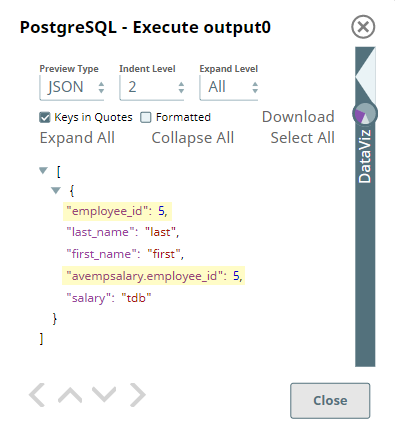On this Page
| Table of Contents | ||||
|---|---|---|---|---|
|
Snap type: | Write | |||||||||||||||||||||||||||||||||||
|---|---|---|---|---|---|---|---|---|---|---|---|---|---|---|---|---|---|---|---|---|---|---|---|---|---|---|---|---|---|---|---|---|---|---|---|---|
| Description: | This Snap allows you to execute arbitrary SQL. Valid JSON paths that are defined in the where clause for queries/statements will be substituted with values from an incoming document. Documents will be written to the error view if the document is missing a value to be substituted into the query/statement.
| |||||||||||||||||||||||||||||||||||
| Prerequisites: | [None] | |||||||||||||||||||||||||||||||||||
| Support and limitations: |
| |||||||||||||||||||||||||||||||||||
| Account: | This Snap uses account references created on the Accounts page of SnapLogic Manager to handle access to this endpoint. See Configuring PostgreSQL Accounts for information on setting up this type of account. | |||||||||||||||||||||||||||||||||||
| Views: |
| |||||||||||||||||||||||||||||||||||
Settings | ||||||||||||||||||||||||||||||||||||
Label | Required.The name for the Snap. You can modify this to be more specific, especially if you have more than one of the same Snap in your pipeline. | |||||||||||||||||||||||||||||||||||
SQL statement | Required.Specifies the SQL statement to execute on the server. There are two possible scenarios that you encounter when working with SQL statements in SnapLogic. You must understand the following scenarios to successfully execute your SQL statements: Scenario 1: Executing SQL statements without expressions
Examples:
Additionally, the JSON path (e.g. $myName) is allowed only in the WHERE clause. If the SQL statement starts with SELECT (case-insensitive), the Snap regards it as a select-type query and executes once per input document. If not, it regards it as write-type query and executes in batch mode. Scenario 2: Executing SQL queries with expressions
Examples:
Known issue: When the SQL statement property is an expression, the Pipeline parameters are shown in the suggest, but not the input schema.
Known issue: The SQL statement will return a PGObject when returning non-standard types.
Default value: [None] | |||||||||||||||||||||||||||||||||||
Pass through | If selected, the input document will be passed through to the output view under the key 'original'. This property applies only to the Execute Snaps with SELECT statement. Default value: Selected | |||||||||||||||||||||||||||||||||||
Ignore empty result | If selected, no document will be written to the output view when a SELECT operation does not produce any result. If this property is not selected and the Pass through property is selected, the input document will be passed through to the output view. Default value: Not selected | |||||||||||||||||||||||||||||||||||
| Number of retries | Specifies the maximum number of attempts to be made to receive a response. The request is terminated if the attempts do not result in a response. Example: 3 Default value: 0
| |||||||||||||||||||||||||||||||||||
| Retry interval (seconds) | Specifies the time interval between two successive retry requests. A retry happens only when the previous attempt resulted in an exception. Example: 10 Default value: 1 | |||||||||||||||||||||||||||||||||||
Auto commit | Select one of the options for this property to override the state of the Auto commit property on the account. The Auto commit at the Snap-level has three values: True, False, and Use account setting. The expected functionality for these modes are:
Default value: Use account setting
| |||||||||||||||||||||||||||||||||||
|
| |||||||||||||||||||||||||||||||||||
Example
The following single-Snap Pipeline runs an SQL query containing a JOIN command to collate data between two PostgreSQL tables.
Let us consider the following tables in a PostgreSQL DB. Notice that the column employee_id is common between these tables.
| Table 1: AVemployees | Table 2: AVempsalary |
|---|---|
The Snap accesses the PostgreSQL tables using a valid account and runs an SQL query that contains a JOIN command based on the following settings:
The output preview after executing this Pipeline displays the result for the SQL query.
Upon joining the two tables as defined in the SQL query, we can see the employee_id column in the second table is prefixed with its table name AVempsalary to differentiate it from the column with the same name in the AVemployees table. This is how the PostgreSQL - Execute Snap handles column with conflicting names in tables when the SQL statement contains a JOIN command.
| Attachments | ||
|---|---|---|
|
| Insert excerpt | ||||||
|---|---|---|---|---|---|---|
|
.png?version=1&modificationDate=1489886486706&cacheVersion=1&api=v2)




